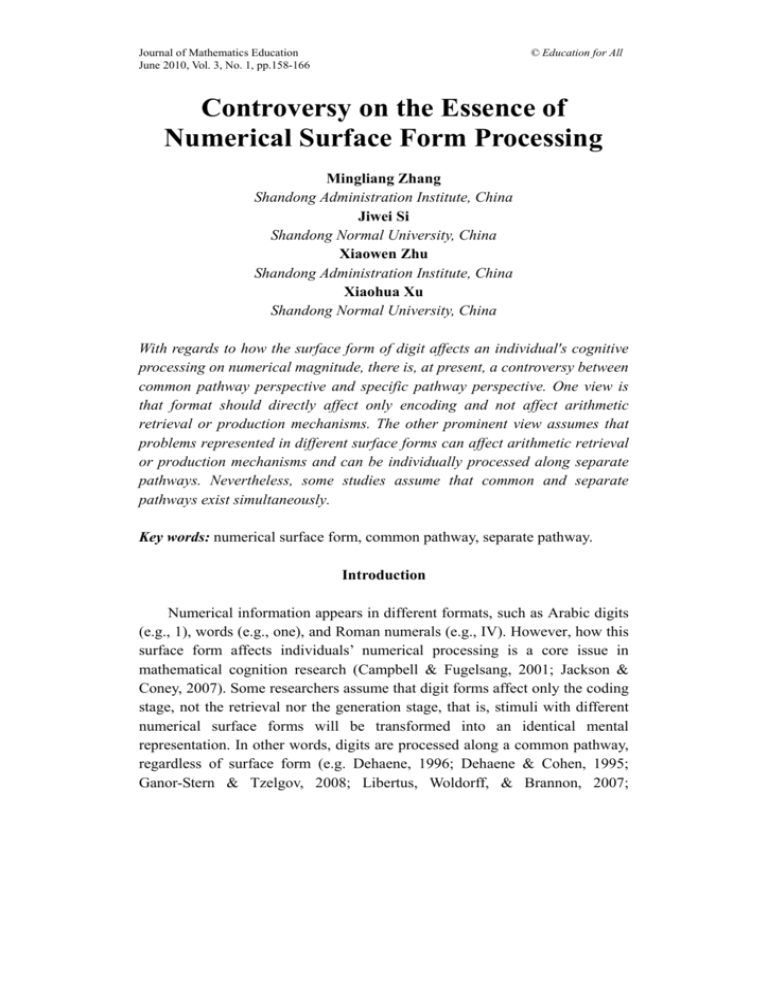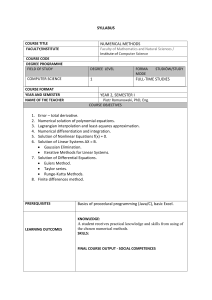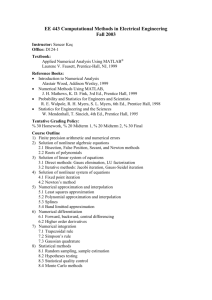Controversy on the Essence of Numerical Surface
advertisement

Journal of Mathematics Education June 2010, Vol. 3, No. 1, pp.158-166 © Education for All Controversy on the Essence of Numerical Surface Form Processing Mingliang Zhang Shandong Administration Institute, China Jiwei Si Shandong Normal University, China Xiaowen Zhu Shandong Administration Institute, China Xiaohua Xu Shandong Normal University, China With regards to how the surface form of digit affects an individual's cognitive processing on numerical magnitude, there is, at present, a controversy between common pathway perspective and specific pathway perspective. One view is that format should directly affect only encoding and not affect arithmetic retrieval or production mechanisms. The other prominent view assumes that problems represented in different surface forms can affect arithmetic retrieval or production mechanisms and can be individually processed along separate pathways. Nevertheless, some studies assume that common and separate pathways exist simultaneously. Key words: numerical surface form, common pathway, separate pathway. Introduction Numerical information appears in different formats, such as Arabic digits (e.g., 1), words (e.g., one), and Roman numerals (e.g., IV). However, how this surface form affects individuals’ numerical processing is a core issue in mathematical cognition research (Campbell & Fugelsang, 2001; Jackson & Coney, 2007). Some researchers assume that digit forms affect only the coding stage, not the retrieval nor the generation stage, that is, stimuli with different numerical surface forms will be transformed into an identical mental representation. In other words, digits are processed along a common pathway, regardless of surface form (e.g. Dehaene, 1996; Dehaene & Cohen, 1995; Ganor-Stern & Tzelgov, 2008; Libertus, Woldorff, & Brannon, 2007; Mingliang Zhang, Xiaowen Zhu, Jiwei Si,Xiaohua Xu 159 McCloskey, Macaruso & Whetstone, 1992; Pinel, Dehaene, Rivie, & LeBihan, 2001). But other researchers argue that the numerical surface form affects the coding phase, the retrieval and generation phases, i.e., stimuli maintain their surface specificities throughout processing by various separate pathways (e.g. Campbell, 1994, 1999; Campbell & Clark, 1992; Campbell & Fugelsang, 2001; Jackson & Coney, 2007; Kadosh, 2008; Metcalfe & Campbell, 2008; Roggeman, Verguts, & Fias, 2007). But there are also a few researchers who believe that the common pathway and the separate pathway may co-exist (e.g. Kadosh, Kadosh, Kaas, Henik, & Goebe, 2007; Nieder, Diester, & Tudusciuc, 2006). In view of the above theoretical controversy, researchers have carried out many empirical explorations in recent decades. Campbell and Clark (1992) confirmed a main hypothesis of the abstraction-representation model, that is, the retrieval stage may already achieve an independent computation module to be insensitive to the primitive form of problem stimulation. Their findings discovered a remarkable interaction between numerical surface forms (Arabic numeral form and visual-verbal numeral form) and problem size effect. They provided the initial supports for the effect of numerical surface forms on answer retrieval. However, McCloskey, Macaruso, and Whetstone (1992) believed the difference of numerical surface forms discovered by Campbell and Clark (1992) might merely be caused by different encodings because the response retrieval to visual-verbal numerical form problem must face the greater speed pressure in comparison to the Arabic numeral form. Moreover, the above difference may be attributed to the following two points: first, the encoding time of visual-verbal numerical form problems is longer than Arabic numeral form problems; second, the occurrence probability of the former is also obviously smaller than the latter. Campbell (1994) further found that the interaction among tasks (addition task and multiplication task), problem size effect and numerical surface forms (visual-verbal and Arabic) were also significant, which was too difficult to explain in terms of the differences in encoding processing. He believed that such a result provided some evidence for the separate pathway perspective. However, Campbell also pointed out that if the problem size effect is different just for the operation tasks, the bigger problem with more attention resources would be disturbed more obviously under those digit forms which need more attention resources to encode (e.g. verbal form). 160 Controversy on the Essence of Numerical Surface Form Processing The Evidence of Common Pathway Hypothesis A vast amount of researchers tried to split the encoding effect from retrieval processing but drew different conclusions. Some of them provided abundant evidence for the common pathway hypothesis, such as in Dehaene and Cohen’s study (1995). These two scholars believed that numerical magnitude was abstractly represented at the bilateral intraparietal sulcus (IPS), and received some support from other research (e.g. Dehaene, 1996). Pinel et al. (2001) also found that verbal numerals and Arabic numerals activated different brain regions with the aid of fMRI and ERP techniques, but they also identified areas influenced solely by the numerical distance between numbers as compared to the independent input notation. This implied that there existed a shared central semantic representation system isolated from numerical surface forms. In a number comparison tasks, Libertus et al. (2007) also found that, by ERP technique the amplitude of P2p component was greater when the numeral value in Arabic form (1-4 and 6-9) was near the standard value (5), and smaller when the numeral value was deviated from the standard value, but vice versa for numerals in dot matrix form. This finding shows an abstract semantic processing phase independent of numerical form in a number comparison task. More recently, Ganor-Stern and Tzelgov (2008) applied the size-comparison and same-different paradigms to explore the existence of across-notation automatic numerical processing. They found that the number with different forms (Arabic numerals and Hindi numerals) could be automatically converted to a common magnitude representation. Thus their results support the key assumptions of the abstract representation model. The Evidence of Separate Pathway Hypothesis Additional research provides support for the separate pathway hypothesis from different perspectives. For example, Campbell (1999) attempted to examine the effect of encoding on Format X Size interaction (word problems were slower than digit problems and this word-format cost was larger for large- than small-number problems) by controlling time factor (operands either were displayed simultaneously or sequentially with the left operand appearing 800 ms before the right operand). He believed that the difference of encoding under the sequential condition could only attribute to the second operand, as an individual has sufficient time to process the first operand before the second Mingliang Zhang, Xiaowen Zhu, Jiwei Si,Xiaohua Xu 161 operand’s occurrence. Moreover, if the interaction mainly stemmed from the encoding stage, the amount of the interaction under the sequential conditions should be half under the simultaneous conditions. His results showed that the interactions in simultaneous and sequential conditions were not significantly different. They implied that those interactions mainly stemmed from the response retrieval or generation phase. Campbell and Fugelsang (2001) further found that numerical surface forms even affected the choice of computation strategy. Thus, these findings provide more evidence for the view that numerical surface forms would affect the response retrieval or generation stage. Moreover, Jackson and Coney (2007) found the priming effect of Arabic numeral form problems was obviously bigger than visual-verbal form problems under long SOA condition in multiplication operation and under short SOA condition in addition operation. Thus, their results also provided the additional support for the separate pathway hypothesis. As a supplement, Roggeman, Verguts, and Fias (2007) observed the quantity difference of the priming effect between Arabic form and dot matrix form. They inferred the Arabic numeral form activated the mental representation of place coding type, but the dot matrix numeral form activated the mental representation of the summation coding type. More recently, Metcalfe and Campbell (2008) expanded numerical surface forms from visual channel to auditory channel and found a remarkable interaction between numerical surface forms (auditory English numeral form and Arabic numeral form), operation tasks (addition and multiplication) and problem size effect. In details, the problem size effect with auditory English numeral form in multiplication operation is smaller than Arabic numeral form, but vice versa in addition operation. But according to Campbell, Fuchs-Lacelle and Phenix (2006), the answer retrieval of addition and multiplication follows the same representation principle. Some other scholars also supposed two operands will be transformed into inert quantity representations (Campbell, 1994). Therefore, the encoding processes of multiplication and addition problems may be consistent (Metcalfe & Campell, 2008). The above opposite tendencies of problem size effect in two numerical forms and operation tasks confirmed the separate pathway hypothesis. The Evidence of Common and Separate Pathway Coexist Hypothesis It is notable that a few scholars also have acquired evidence supporting the hypothesis that common pathway and separate pathway may coexist. Recently, Nieder, Diester, and Tudusciuc (2006) observed that a certain 162 Controversy on the Essence of Numerical Surface Form Processing proportion of neurons in IPS related numerical magnitude, but it is insensitive to numerical surface forms, and some other neurons are sensitive to numerical surface forms. Thus it is possible that numerical format-dependent processing and abstract processing coexist in IPS. Kadosh et al. (2007) further revealed a functional asymmetry on the parietal lobe between the left hemisphere and right hemispheres. Their results indicated that abstract representation mainly focused on the left parietal lobe, but numerical format-dependent and non-abstract representation mainly focused on the right parietal lobe, which supported the coexisting hypothesis. In sum, previous researchers didn’t reach a unified understanding on the debate between the common pathway and separate pathways. It is necessary to develop further studies to find more evidence for such a crucial debate in numerical cognition literature. Lack of Research and Outlook Numerical Surface Form Most previous studies adopted Arabic numerals and visual-verbal numerical forms to investigate the essence of numerical forms. But the visual-verbal numerical form is relatively rare for Chinese. The occurrence probability of visual-verbal numerical form problems is obviously smaller than Arabic numeral form problems. As the occurrence probability of numerical surface forms used in previous research, obvious differences exist in, conclusions drawn from them are also worth reconsidering to a certain extent. In reality, with regard to Chinese, Arabic numeral is also the most common numerical form during multiplication operations. Their special learning experiences on skillfully reciting multiplication tables result in the auditory-verbal numerical form is more common than Westerns. The Research Paradigms In addition, many previous studies attempted to reveal whether the numerical surface form effect should stem from the encoding or retrieving mechanism through the interaction between numerical forms and problem size effect. Jackson and Coney (2007) thought such an interaction could not be used to make an affirmation to the essence of numerical forms because the size effect and could not be compared with numerical surface forms until the difference between bigger problems and smaller problems were kept near Mingliang Zhang, Xiaowen Zhu, Jiwei Si,Xiaohua Xu 163 equal in different numerical forms. Several studies have stressed the importance of the parietal lobe in response selection (e.g., Jiang & Kanwisher, 2003). A recent study has shown that response selection and number processing activate the same areas in the IPS (GÖbel et al., 2004). However, previous studies were mostly obtained when participants deliberately conducted numerical processing. Therefore, it could be argued that they reflect mainly the task requirement and not the features of internal mental representation. According to Tzelgov and his colleagues, mental representations are best probed when their processing is automatic and not part of the requirement of the task that is intentionally performed (e.g. Ganor-Stern & Tzelgov, 2008). This approach to automaticity postulates that to diagnose a process as automatic, it is necessary to show that it can take place when it is not part of the task requirement. Accordingly, to study the characteristics of numerical representation, the size congruity effect may be useful. When a stimulus has two dimensions but only one has to be considered while the other has to be ignored, participants process the irrelevant dimension unintentionally. For example, in number comparison, participants have to relate to the numerical value and ignore the physical size. In the congruent condition, one of the two digits is larger in both dimensions (e.g., 3 7). In the incongruent condition, one of the digits is larger in one dimension, while the other is larger in the second dimension (e.g., 3 7). In the neutral condition, there is no difference in the irrelevant dimension (e.g., 2 4). The SCE is observed when incongruent and congruent conditions differ significantly. Facilitation is observed when the response to the congruent trials is faster than in the neutral trials. Interference is observed when the response to the incongruent trials is slower than in the neutral trials. Functional magnetic resonance adaptation (fMRA) is an innovative paradigm within the general fMRI method, which relies on the phenomenon that brain activation is reduced when the same stimulus is presented in trial n – 1 and in trial n. The adaptation effect has been interpreted as reflecting a reduction in the spiking rates of the adapted neuronal population (Grill-Spector, Henson, & Martin, 2006). With respect to the research of the present work, it is noteworthy that recent studies were successful in exploring the properties of numerical representations with fMRA by employing a passive-viewing task (Cantlon et al., 2006). Furthermore, the research on supporting “common pathway” also exists in the following two deficiencies: (1) RT data is not sufficient. Stimuli that yield similar response functions can still, theoretically, be processed by distinct 164 Controversy on the Essence of Numerical Surface Form Processing mechanisms. (2) Lack of anatomical resolution. There may be segregated neuronal representations that cannot be revealed by a conventional functional magnetic resonance imaging (fMRI) analysis, which is typically confined to a resolution of about 3 × 3 × 3 mm. Moreover, highly specialized neurons may be co-localized within a single fMRI voxel (Grill-Spector and Malach, 2001). This problem is aggravated using spatial smoothing, which might cause blurring of activation over several voxels, and/or pooling the activation across subjects (Goebel et al., 2006). Note: This research is supported by the following funds: Mount Tai Scholar Project of Shan Dong Province; International Cooperation and Cultivation Project for Excellent Core College Faculty of Shandong Provincial Education Department. References Campbell, J. I. D. (1994). Architectures for numerical cognition. Cognition, 53, 1-44. Campbell, J. I. D. (1999). The surface form × problem size interaction in cognitive arithmetic: evidence against an encoding locus. Cognition, 70, 25-33. Campbell, J. I. D., & Clark, J. M. (1992). Cognitive number processing: An encoding complex perspective. In J. I. D. Campbell (Ed.), The nature and origins of mathematical skills (pp.457-492). North-Holland: Elsevier Science Publishers. Campbell, J. I. D., Fuchs-Lacelle, S., & Phenix, T. L. (2006). Identical elements model of arithmetic memory: Extension to addition and subtraction. Journal of experimental psychology: Learning, memory, and cognition, 34, 633-647. Campbell, J. I. D., & Fugelsang, J. (2001). Strategy choice for arithmetic verification: effects of numerical surface form. Cognition, 80, 21-30. Cantlon, J. F., Brannon, E. M., Carter, E. J., & Pelphrey, K. A. (2006). Functional imaging of numerical processing in adults and 4-y-old children. PLoS Biology, 4(5), 0844-0854. Dehaene, S. (1996). The organization of brain activations in number comparison: event-related potentials and the additive-factors method. Journal of Cognition Neuroscience, 8(1), 47-68. Dehaene, S., & Cohen, L. (1995). Toward an anatomical and functional model Mingliang Zhang, Xiaowen Zhu, Jiwei Si,Xiaohua Xu 165 of number processing. Mathematical Cognition, 1, 83-120. Ganor-Stern, D., & Tzelgov, J. (2008). Across-notation automatic numerical processing. Journal of Experimental Psychology: Learning, Memory, and Cognition, 34, 430-437. Goebel, R., Esposito, F., & Formisano, E. (2006). Analysis of functional image analysis contest (FIAC) data with Brainvoyager QX: From single-subject to cortically aligned group general linear model analysis and self-organizing group independent component analysis. Human Brain Mapping, 27, 392-401. GÖbel, S. M., Johansen-Berg, H., Behrens, T., & Rushworth, M. F. S. (2004). Response-selection-related parietal activation during number comparison. Journal of Cognitive Neuroscience, 16, 1536-1551. Grill-Spector, K., & Malach, R. (2001). FMR-adaptation: A tool for studying the functional properties of human cortical neurons. Acta Psychologica, 107, 293-321. Grill-Spector, K., Henson, R., & Martin, A. (2006a). Repetition and the brain: Neural models of stimulus-specific effects. Trends in Cognitive Sciences, 10, 14-23. Jackson, N. D., & Coney, J. R. (2007). Simple arithmetic processing: Surface form effects in a priming task. Acta Psychologica, 125, 1-19. Jiang, Y., & Kanwisher, N. (2003). Common neural substrates for response selection across modalities and mapping paradigms. Journal of Cognitive Neuroscience, 15, 1080-1094. Kadosh, R. C. (2008). Numerical representation: Abstract or nonabstract? The Quarterly Journal of Experimental Psychology, 61, 1160-1168. Kadosh, R. C., Kadosh, K. C., Kaas, A., Henik, A., & Goebe, R. (2007). Notation-dependent and –independent representations of numbers in the parietal Lobes. Neuron, 53, 307-314. Libertus, M. E., Woldorff, M. G., & Brannon, E. M. (2007). Electrophysiological evidence for notation independence in numerical processing. Behavioral and Brain Functions, 3, 1-15. McCloskey, M., Macaruso, P., & Whetstone, T. (1992). The functional architecture of numerical processing mechanisms: Defending the modular model. In J. I. D. Campbell (Ed.), The nature and origins of mathematical skills (pp. 493–538). North-Holland: Elsevier Science Publishers. Metcalfe, A. W., & Campbell, J. I. D. (2008). Spoken numbers versus Arabic numerals: differential effects on adults' multiplication and addition. 166 Controversy on the Essence of Numerical Surface Form Processing Canadian Journal of Experimental Psychology, 62, 56-61. Nieder, A., Diester I., Tudusciuc O. (2006). Temporal and spatial enumeration processes in the primate parietal cortex. Science, 313, 1431-1435. Pinel, P., Dehaene, S., Rivie `re, D., & LeBihan, D. (2001). Modulation of parietal activation by semantic distance in a number comparison task. NeuroImage, 14, 1013-1026. Roggeman, C., Verguts, T., & Fias, W. (2007). Priming reveals differential coding of symbolic and non-symbolic quantities. Cognition, 105, 380-394. Authors: Mingliang Zhang Shandong Administration Institute, China Email: mingliang1@126.com Jiwei Si Shandong Normal University, China Email: sijiwei1974@126.com Xiaowen Zhu Shandong Administration Institute, China Email: allay@126.com Xiaohua Xu Shandong Normal University, China Email: sue35727@126.com








